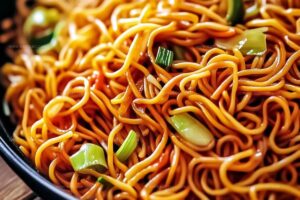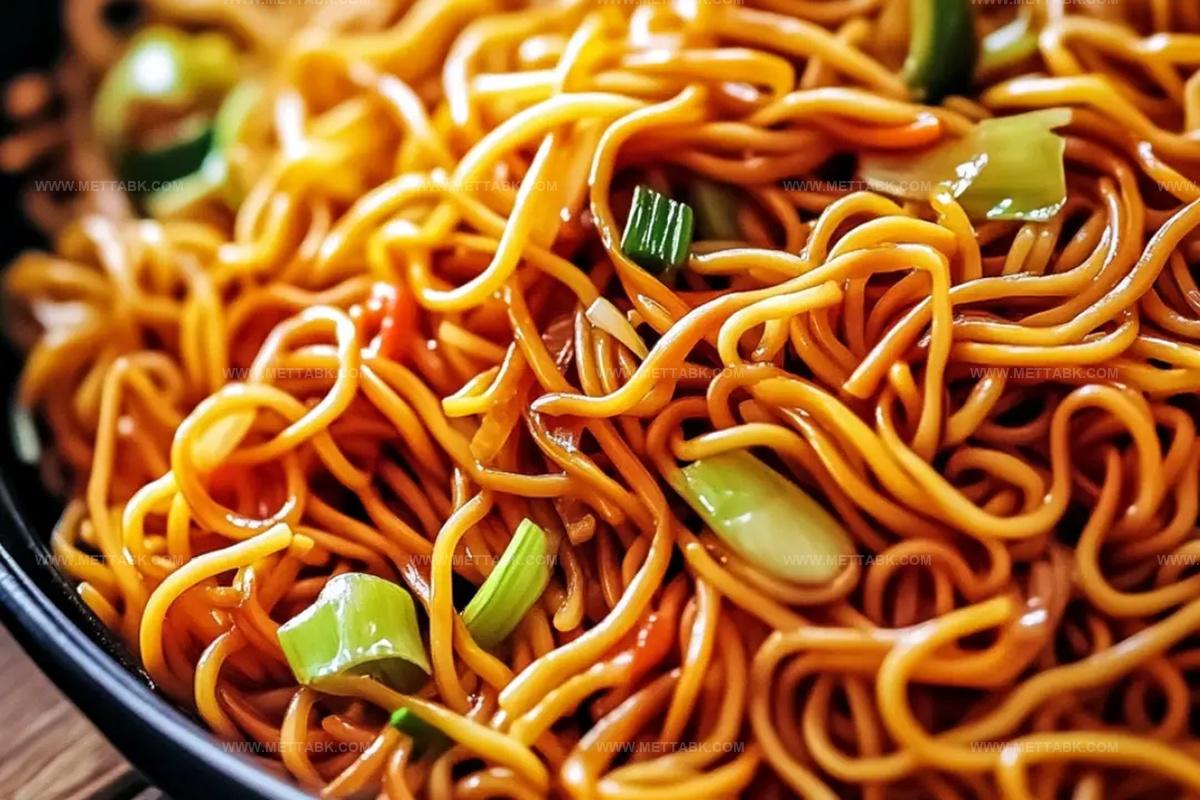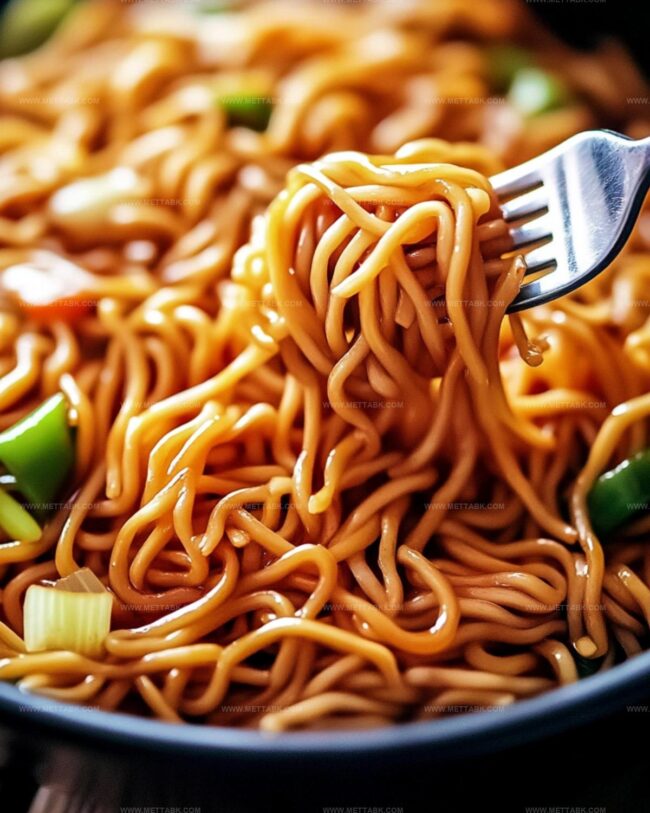The Best Panda Express Chow Mein Recipe for Home Cooks
Craving a delicious chow mein that rivals your favorite panda express experience?
Noodles dance with vibrant vegetables in this mouthwatering copycat recipe that brings restaurant magic straight to your kitchen.
Crisp cabbage and tender carrots create a perfect balance of textures and flavors.
Savory sauce coats each strand, promising an authentic taste adventure.
Skilled home cooks can whip up this crowd-pleasing dish in under 30 minutes.
Wok-tossed ingredients blend seamlessly, delivering a restaurant-quality meal without leaving your home.
Prepare to impress everyone at the dinner table with this irresistible noodle sensation.
Proper Storage for Panda Express Chow Mein
FAQs
Egg noodles or fresh yakisoba noodles are ideal, as they have the perfect texture and authentic flavor for traditional chow mein.
Yes, simply omit any meat and focus on the delicious vegetable mix. The sauce and noodles provide plenty of flavor and protein.
The recipe is mild, but you can add red pepper flakes or sriracha sauce if you want extra heat. The current version is family-friendly and not inherently spicy.
Absolutely! The ingredients are simple, the flavors are mild, and most children enjoy noodle dishes like this chow mein.
Panda Express Chow Mein Copycat Recipe
Ingredients for Panda Express Chow Mein
For the Noodles:For the Vegetables:For the Sauce Ingredients:For the Cooking Liquids:For the Seasoning:Step-by-Step Panda Express Chow Mein Guide
Step 1: Boil Delightful Noodles
Grab your chow mein noodles and cook them perfectly in boiling water following the package instructions. Once they’re beautifully tender, drain them in a colander and set aside.
Step 2: Sizzle Vibrant Vegetables
Warm vegetable oil in a large wok or skillet over medium-high heat. Toss in:Stir these colorful veggies occasionally and cook until they become wonderfully soft and slightly translucent (around 5 minutes).
Step 3: Whisk Flavor-Packed Sauce
In a small mixing bowl, blend together:Whisk these ingredients until they create a smooth, aromatic sauce.
Step 4: Merge Noodles and Veggies
Slide the cooked noodles into the skillet with the sauteed vegetables.
Pour the prepared sauce over everything, then toss and stir enthusiastically to ensure every strand gets coated with delicious flavor.
Step 5: Final Sizzle and Serve
Continue cooking for a few more minutes, stirring frequently.
Make sure the noodles are heated through and glistening with sauce. Remove from heat and serve immediately for maximum deliciousness!
Tips for Perfect Panda Express Chow Mein
Variations of Panda Express Chow Mein
Pairing Ideas for Panda Express Chow Mein
Print
Panda Express Chow Mein Recipe
- Total Time: 25 minutes
- Yield: 4 1x
Description
Panda Express chow mein brings classic Chinese-American stir-fry magic right to home kitchens with restaurant-quality noodles that dance with crisp vegetables and savory sauce. Quick and satisfying, you’ll master this takeout favorite in minutes, creating a delicious meal that rivals any restaurant version.
Ingredients
Main Ingredients:
- 6 ounces (170 grams) chow mein noodles
- 2 1/2 cups sliced green cabbage
- 1 cup thinly sliced onion
Sauce and Seasoning:
- 3 tablespoons soy sauce
- 2 tablespoons hoisin sauce
- 1 tablespoon minced garlic
- 1 teaspoon ginger paste
Cooking Ingredients:
- 2 tablespoons vegetable oil
- Salt to taste
- Pepper to taste
Instructions
- Bring a pot of water to a rolling boil and cook the chow mein noodles according to package instructions, ensuring they are al dente. Drain thoroughly and set aside.
- Place a large wok or skillet over medium-high heat, adding vegetable oil to create a smooth cooking surface. Introduce sliced onions and shredded cabbage, tossing gently and allowing them to become translucent and slightly tender, approximately 4-5 minutes.
- Create a flavor base by blending minced garlic, ginger paste, soy sauce, hoisin sauce, salt, and black pepper in a small mixing bowl. Whisk until the ingredients form a harmonious, aromatic sauce.
- Transfer the prepared noodles into the vegetable-filled wok, carefully folding them to integrate with the sautéed vegetables. Gradually pour the sauce mixture over the noodles, using tongs or a spatula to ensure complete and even coating.
- Continue cooking for an additional 2-3 minutes, stirring constantly to prevent sticking and promote uniform heating. Once the noodles are steaming hot and glistening with sauce, remove from heat and plate immediately for optimal flavor and texture.
Notes
- Rinse noodles with cold water after cooking to prevent sticking and maintain a slippery, smooth texture.
- Cut vegetables into uniform sizes for even cooking and consistent texture throughout the dish.
- Adjust sauce ingredients to personal taste, adding more soy sauce for saltiness or hoisin for sweetness.
- Swap wheat noodles with gluten-free options or use tamari instead of soy sauce for a gluten-free version.
- Prep Time: 15 minutes
- Cook Time: 10 minutes
- Category: Lunch, Dinner, Appetizer, Snacks
- Method: Sautéing
- Cuisine: Chinese
Nutrition
- Serving Size: 4
- Calories: 300 kcal
- Sugar: 5 g
- Sodium: 900 mg
- Fat: 12 g
- Saturated Fat: 1.5 g
- Unsaturated Fat: 10.5 g
- Trans Fat: 0 g
- Carbohydrates: 40 g
- Fiber: 3 g
- Protein: 7 g
- Cholesterol: 0 mg



Nate Harper
Founder & Recipe Curator
Expertise
Single-Recipe Development, Farm-to-Table Cooking, Seasonal Menu Planning, Culinary Storytelling, Home Kitchen Innovation
Education
Cascade Culinary Institute – Central Oregon Community College
Certificate in Culinary Arts
Focus: Farm-to-table cuisine, sustainable cooking practices, and seasonal recipe creation.
Nate studied under experienced chefs who emphasized local sourcing, minimal waste, and building recipes from fresh, simple ingredients.
Nate Harper is the founder and creative force behind Make, Take, Bake. Raised in the wild beauty of Oregon’s high desert, Nate grew up surrounded by family gardens, farmers’ markets, and home kitchens that celebrated the seasons.
His early love for simple, honest food evolved into a professional passion when he attended Cascade Culinary Institute, where he sharpened his skills in creating recipes that are sustainable, satisfying, and made for everyday life.
Nate’s goal is to make cooking feel accessible, free of fuss, and full of flavor. He believes a single, thoughtfully built dish can stand alone, and sometimes even steal the show.